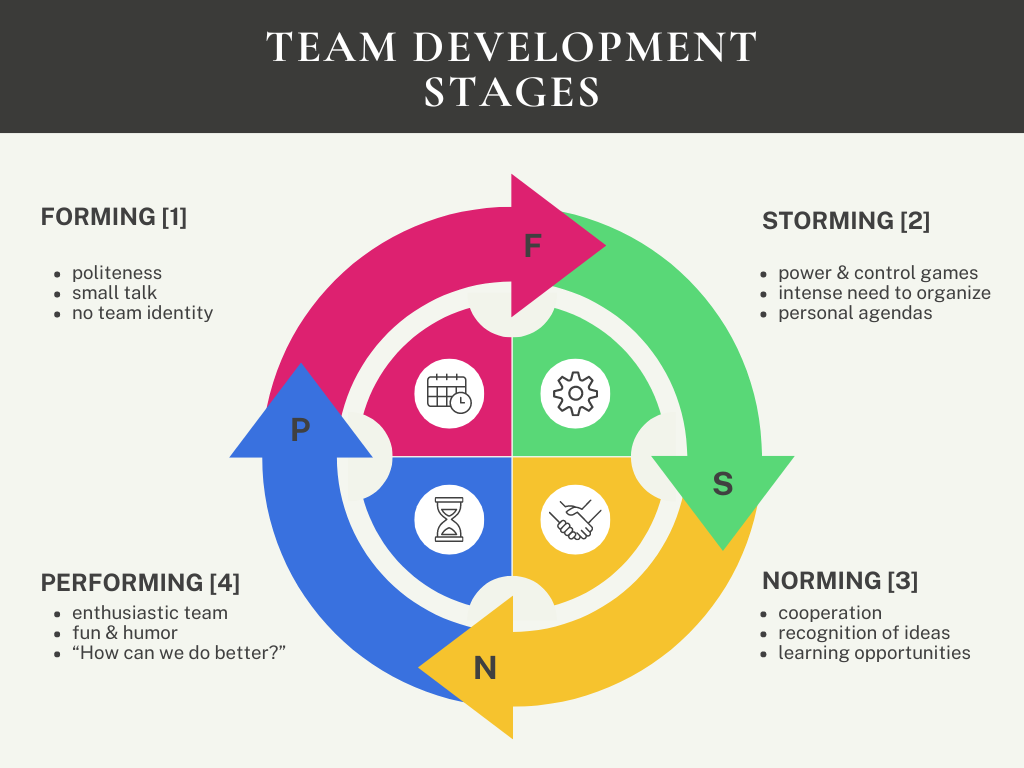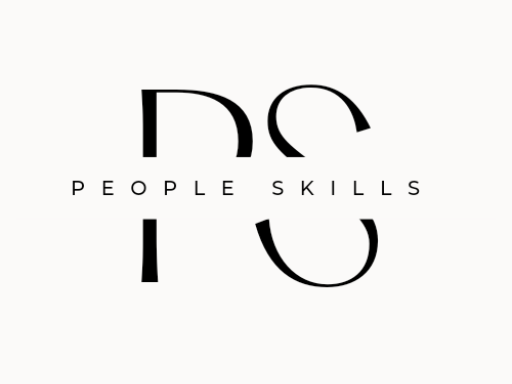The concept of team development stages sits at the foundation of understanding how groups evolve and mature over time. Initially proposed by Bruce Tuckman in 1965, the four stages of team development: Forming, Storming, Norming, and Performing; provide a roadmap for managers and team leaders to navigate the complexities of group development and foster effective collaboration.
The aim of this article is to act as a comprehensive guide, by diving into each stage, exploring their characteristics, and discuss strategies and activities to facilitate smooth transitions from one stage to the next.

The Forming Stage: Building Foundations
The Forming stage marks the initial phase of team formation.
This stage is often characterized by surface-level interactions between the team members, showing extreme politeness, added to an increased sense of uncertainty within members. Individuals may engage in small talk, but the discussion will be limited to safe topics as people are on a lookout for acceptance and establishing rapport. Personal details are often not shared as newcomers question their acceptance within the group.
To facilitate progress through the Forming stage, managers can implement activities such as meet-and-greet sessions, icebreakers, and clear formulation of expectations. Out-of-office activities and assessment workshops can also help team members socialize and build trust. It’s essential for leaders to take the lead in discussions and create a supportive environment where individuals feel valued and accepted.
During the forming stage, there is no team identity and the sense of belonging is lacking. At this point, individuals are still uncomfortable and focus on understanding their place. It’s the responsibility of the leader to show initiative and work on getting from the individual identity toward a group identity.
Imagine a scenario where a new project team is formed within a company. As the team gathers for their first meeting, there are polite introductions and small talk about weekend plans or hobbies. People may be a bit reserved, wondering how they’ll fit into the newly formed group and whether they and/or their ideas will be accepted.
The Storming Stage: Navigating Conflict and Resistance
As teams move into the Storming stage, power struggles, resistance to change, and conflicting agendas may emerge. Team members may rebel against new ideas or challenge existing norms, leading to a lack of cohesion. This stage requires intense organizational efforts from the manager’s side. Clear procedures and rules need to be formulated and will be essential to manage conflicts and establish a sense of order.
To navigate the Storming stage effectively, teams can engage in problem-solving activities, group discussions, and consensus-building exercises. Establishing work methods and agreements on various topics can help align individual interests with collective goals. Leaders should promote open communication, address conflicts proactively, and reinforce team norms to foster collaboration and minimize disruptions.
In the Storming stage, tensions may arise as individuals assert their opinions and battle for influence within the team. Picture a team discussion, where different team members advocate for conflicting approaches to solving a problem. Some may resist change, preferring to stick to familiar methods, while others push for innovation. This stage can feel a bit like a tug-of-war as the team deals with competing priorities and personalities.
The Norming Stage: Cultivating Cooperation and Cohesion
In the Norming stage, teams begin to reconcile past issues and develop a cooperative spirit, while individual contributions to the group are being recognized. Cohesion increases as members work together towards common goals. At this stage ideas are acknowledged and respected. The adoption of a democratic leadership style supports the promotion of inclusivity and help increase engagement.
To nurture progress through the Norming stage, leaders should provide opportunities for team members to participate in decision-making and problem-solving activities. Recognizing individual and group efforts, offering constructive feedback, and providing learning opportunities can further enhance teamwork and morale. Monitoring team energy and collaboration levels is essential to sustain momentum and foster a supportive work environment going forward.
As the team progresses into the Norming stage, they begin to find their rhythm and work together more effectively. Consider a scenario where a sports team has been practicing together for a few weeks. Players start to understand each other’s strengths and weaknesses, and there’s a sense of camaraderie on and off the field. They develop a shared language and strategy, focusing on the collective goal of winning games rather than individual badges.
The Performing Stage: Achieving Excellence and Innovation
The Performing stage represents the peak of team development, characterized by high levels of enthusiasm, independence, and a commitment to excellence. Team members are empowered to apply established processes effectively and engage in continuous improvement efforts. Constructive feedback is embraced, and a culture of openness and innovation prevails.
To reinforce and maintain the Performing stage, leaders can celebrate success and milestones, delegate responsibilities effectively, and encourage group decision-making and problem-solving. It’s essential to avoid complacency and recognize when change is necessary to avoid stagnation. Creating opportunities for knowledge sharing and cross-team collaboration facilitate ongoing learning and growth.
In the Performing stage, the team operates like a well-oiled machine, achieving outstanding results and pushing the boundaries of what’s possible. Imagine a music band that has been touring together for years. They know each other’s musical cues instinctively and can improvise seamlessly during live performances. There’s a sense of trust and synergy among band members, allowing them to create unforgettable music experiences for their audience.
Managing Transitions and Challenges
While progressing through team development stages, it’s important to acknowledge that setbacks and challenges may occur. Teams may regress to previous stages due to changes in personnel or shifting priorities. Managers must be vigilant and proactive in addressing issues, whether through coaching, training, or reshaping team dynamics.
If the Performing stage persists for too long, performance may decline, signaling the need for change and adaptation. Whitney Johnson, in her book: “Build and A Team” illustrates the S-curve model, showing how individuals evolve over time, with periods of growth followed by plateaus and potential decline. Embracing change as a natural part of the team’s evolution allows for continued innovation and renewal.
Throughout the team’s journey, it’s important for leaders to be adaptable and responsive to changing circumstances. Whether it’s integrating new team members, addressing conflicts, or celebrating successes, effective communication and collaboration are key. By recognizing the unique characteristics of each stage and providing the necessary support and guidance, teams can overcome challenges and continue to evolve and thrive in today’s fast paced work environments.
Assessing Your Team’s Development Stage
Based off Bruce Tuckman’s work, Erin Barkema and John W. Moran have developed a questionnaire that will help you assess in what stage your team is currently situated.
The questionnaire consists of 32 questions that should be answered with a score, from 1 to 5, as follows: 1 = Almost never / 2 = Seldom / 3 = Occasionally / 4 = Frequently / 5 = Almost always.
I would recommend doing the test first yourself, assessing your team objectively, at your own pace, and later repeating the exercise together with the team. This way you will (hopefully) not be taken by surprise by the result and also will be able to offer guidance in case some questions are not well understood.
This team exercise will raise awareness across the team about the existing of the development stages and can be a good starting point for discussing how the team can conscientiously move to the next stage.
The questions are the following:
- We try to have set procedures or protocols to ensure that things are orderly and run smoothly (e.g. minimize interruptions; everyone gets the opportunity to have their say).
- We are quick to get on with the task at hand and do not spend too much time in the planning stage.
- Our team feels that we are all in it together and shares responsibilities for the team’s success or failure.
- We have thorough procedures for agreeing on our objectives and planning the way we will perform our tasks.
- Team members are afraid or do not like to ask others for help.
- We take our team’s goals and objectives literally, and assume a shared understanding.
- The team leader tries to keep order and contributes to the task at hand.
- We do not have fixed procedures; we make them up as the task or project progresses.
- We generate lots of ideas, but we do not use many because we fail to listen to them and reject them without fully understanding them.
- Team members do not fully trust the other team members and closely monitor others who are working on a specific task.
- The team leader ensures that we follow the procedures, do not argue, do not interrupt, and keep to the point.
- We enjoy working together; we have a fun and productive time.
- We have accepted each other as members of the team.
- The team leader is democratic and collaborative.
- We are trying to define the goal and what tasks need to be accomplished.
- Many of the team members have their own ideas about the process and personal agendas are rampant.
- We fully accept each other’s strengths and weaknesses.
- We assign specific roles to team members (team leader, facilitator, time keeper, note taker, etc.).
- We try to achieve harmony by avoiding conflict.
- The tasks are very different from what we imagined and seem very difficult to accomplish.
- There are many abstract discussions of the concepts and issues, which make some members impatient with these discussions.
- We are able to work through group problems.
- We argue a lot even though we agree on the real issues.
- The team is often tempted to go above the original scope of the project.
- We express criticism of others constructively.
- There is a close attachment to the team.
- It seems as if little is being accomplished with the project’s goals.
- The goals we have established seem unrealistic.
- Although we are not fully sure of the project’s goals and issues, we are excited and proud to be on the team.
- We often share personal problems with each other.
- There is a lot of resisting of the tasks on hand and quality improvement approaches.
- We get a lot of work done.
When evaluating the result, use the below scoring sheet:

The highest of the 4 scores indicates the stage your team operates from.
If the 4 scores are very similar, it means you have no clear perception of the team’s development stage. In this case, a team discussion is welcome and you can easily turn the completion of the test into a team workshop, amid offering more clarity to both you and the team members.
If scores in Storming and Norming are very similar, you should consider you are still in the Storming phase and more work is to be done.
If scores in Norming and Performing are very similar, you can consider your team is closer to Performing.
Conclusion
Understanding and navigating team development stages is essential for fostering effective collaboration and achieving organizational success. By recognizing the characteristics of each stage and implementing appropriate strategies and activities, leaders can guide their teams through the complexities of group dynamics and cultivate a culture of excellence and innovation. Embracing change and addressing challenges proactively are key to sustaining momentum and driving continuous improvement in today’s challenging work environments.
